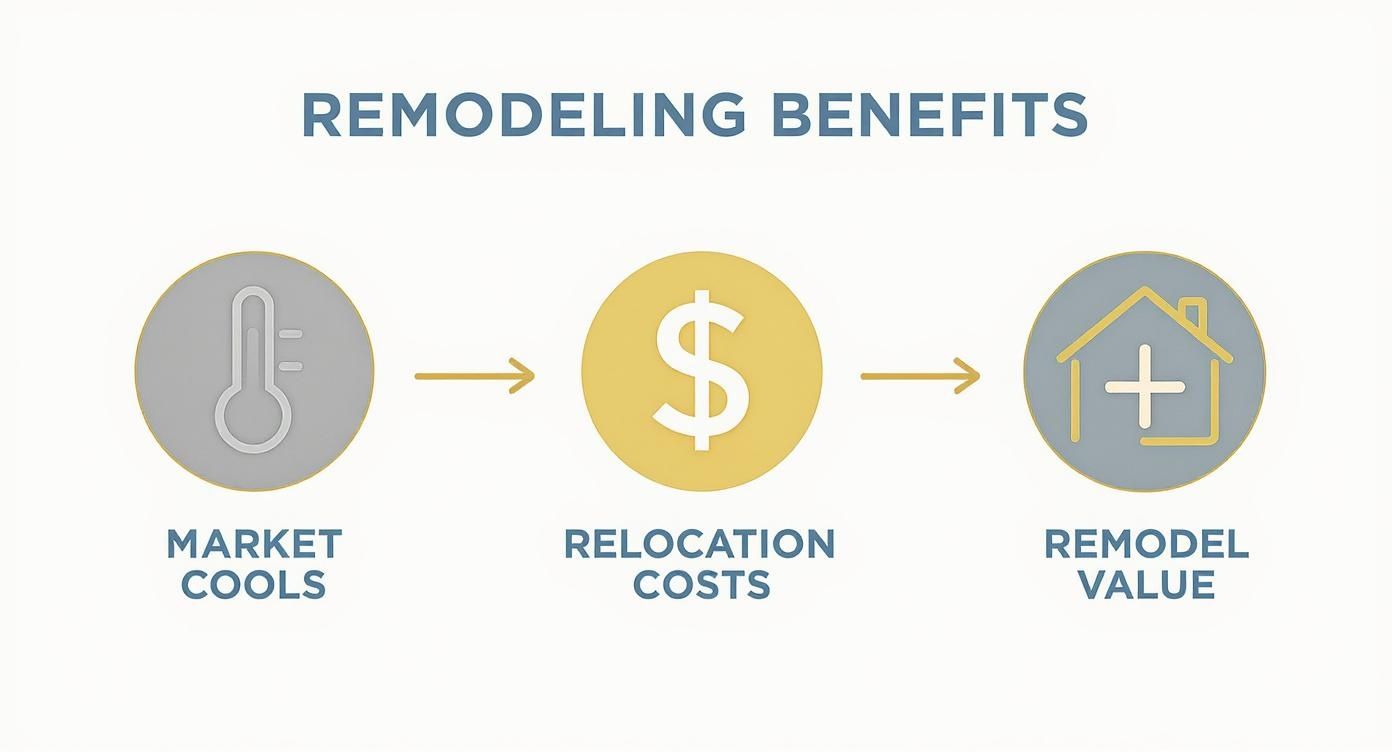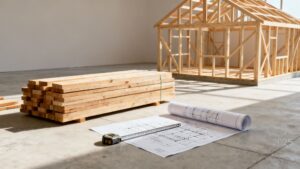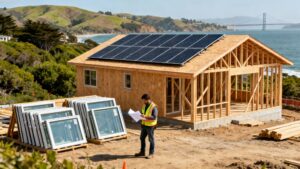If you own a home in the Bay Area, making smart upgrades is a great financial move. Instead of dealing with a slow real estate market, you can invest money back into your own property. This makes it more valuable, comfortable, and efficient without leaving your neighborhood.
Why Staying Put and Upgrading Makes Sense
In today's Bay Area real estate market, the numbers tell a clear story. The wild bidding wars of the past few years have cooled down. This makes selling your home and buying another one less appealing. For homeowners in Berkeley, Oakland, and across the Bay, improving your current space is often the smartest choice.
This shift creates a huge opportunity. You can use the money you would have spent on moving costs for renovations that pay you back. You get more daily enjoyment and better long-term financial returns.
The New Real Estate Reality
The market has changed the math for homeowners. After years of intense competition, things are much calmer now. We're seeing homes sell for just 0-5% over the asking price. This is a big drop from the 10-25% premiums that were common just a few years ago. The big financial reason to move just isn't there anymore, making a good remodel a better investment.
Unlocking Your Home's Potential
By choosing to remodel, you can fix your home's quirks and make it perfect for you. This approach gives you much more control over your costs than the unpredictable housing market. You can put your money into high-impact upgrades that matter, like:
- Boosting Energy Efficiency: New, high-performance windows and doors can lower your utility bills. They also make your home more comfortable all year.
- Modernizing Key Spaces: A kitchen or bathroom update is a classic choice for a reason. It improves your daily life and adds significant resale value.
- Creating More Functional Areas: Removing a wall to create an open living space can change how you enjoy your home. Carving out a dedicated home office is also a popular upgrade.
Choosing to remodel is more than just a new coat of paint. It's a smart investment in your property’s future and your family's quality of life.
A thoughtful renovation lets you boost your home’s value strategically. For ideas, check our guide on which home renovations boost value when you sell your home. This guide will help you make smart upgrades that fit your budget and goals.
To help you weigh your options, here's a quick look at remodeling versus relocating in the Bay Area.
Remodel vs. Relocate: A Quick Comparison
| Factor | Remodeling | Relocating |
|---|---|---|
| Upfront Costs | Lower initial cash needed. You focus on the project budget. | High. Includes down payment, closing costs, moving fees, and realtor commissions. |
| Market Risk | Low. You are protected from market changes. | High. You have to sell and buy in the same cooled-down market. |
| Emotional Toll | Can be disruptive, but you stay in your community. | High stress. Involves house hunting, packing, and moving to a new area. |
| Customization | Total control. You can tailor your home to your exact needs. | Limited. You get what you buy, and any changes will cost extra. |
| Return on Investment | Direct. You add real value and use to your home. | Uncertain. It depends heavily on future market performance. |
Looking at it this way, it's clear why so many Bay Area homeowners are investing in their current homes. You get the upgrades you want without the huge financial and emotional cost of moving.
Creating Your Remodeling Blueprint for Success
A successful remodel starts with a solid plan, not a sledgehammer. This blueprint is the most important part of any project. It helps you remodel smarter, control costs, and get the results you want.
Before you think about materials, get clear on your goals. Do you want an open-concept kitchen for entertaining? Or is boosting energy efficiency with new windows your top priority? Being specific will guide every decision you make.
This infographic shows why remodeling is a smart move in the current Bay Area market.

Alt text: Infographic showing the benefits of remodeling in the Bay Area, including lower market risk and higher return on investment compared to relocating.
As you can see, investing in your current property is a powerful way to build long-term value.
Defining Your Project Scope
Once you know your "why," it’s time to decide on the "what." Outlining your project scope means deciding exactly what the renovation will include. Does a "kitchen remodel" mean new countertops or a full gut job with new appliances and plumbing?
Write these details down. List your "must-have" features and your "nice-to-have" wishes. This list helps prevent "scope creep," where projects grow beyond their original goals and budget.
To see what's possible, you can use tools like 3D rendering for interior design. This helps make sure everyone is on the same page.
Setting a Realistic Budget
With your scope defined, you can create a realistic budget. Bay Area remodeling costs are higher than the national average, so do your homework. A good budget includes "hard costs" like labor and materials, plus "soft costs" people often forget.
Make sure you account for these items:
- Permit Fees: These vary between cities like Berkeley and Oakland.
- Design and Architectural Plans: You often need professional drawings for permits and accurate bids.
- Inspection Costs: Your project will likely need several inspections to meet local codes.
- A Contingency Fund: Set aside an extra 15-20% of your budget. This is your safety net for unexpected issues.
A well-planned budget is a tool that helps you make smart choices without derailing the project.
Researching Local Bay Area Regulations
Before you get too attached to your plans, check local zoning laws and building codes. Regulations in the Bay Area can be complex. Some neighborhoods have rules about exterior materials, while others require seismic upgrades.
Ignoring these rules can lead to fines, delays, or even having to undo completed work. A quick search on your city’s planning department website can save you headaches. This ensures your blueprint is both beautiful and buildable.
To organize every detail, download our free home renovation checklist. It will help you start your project with a clear vision and a documented plan.
Assembling Your Dream Remodeling Team
The success of your remodel depends more on the people you hire than the materials you choose. Finding the right architects, designers, and contractors is the most important step. Building your A-team thoughtfully will save you time, money, and stress.
First, figure out who you need. A simple bathroom update may only need a good general contractor. But a major home addition will require an architect and maybe a designer.

Alt text: A homeowner and contractor review architectural blueprints on a residential construction site, planning a remodel.
Defining Roles: Who Does What?
Knowing what each professional does helps you hire smart. This prevents you from paying for services you don't need.
- Architect: Designs the structural and aesthetic parts of your project. They are essential for additions, moving load-bearing walls, or changing your home's footprint.
- Interior Designer: Focuses on the look and function of your indoor spaces. They help with everything from color palettes to selecting fixtures and materials.
- General Contractor (GC): The project manager who brings the plans to life. They hire subcontractors, manage the schedule, and ensure the work meets local codes.
For many Bay Area remodels, a design-build firm is a great option. These companies offer both design and construction services under one roof. This can simplify communication and create a smoother process.
Vetting Your Bay Area Professionals
Once you know who you need, the real work begins. Referrals from friends are a good start, but always do your own research. Treat interviews with potential team members like a job interview.
Ask about their experience with projects like yours in your specific city. A contractor with deep roots in Berkeley will understand its permitting rules better than one from another area. Our detailed guide on how to choose the right contractor can help.
A contractor's local experience is priceless. Their knowledge of Bay Area building codes and reliable local suppliers like Truitt & White is a huge asset.
Skilled contractors in the region typically charge between **$75 and $150 per hour. A recent slowdown in new construction has increased contractor availability. This might mean shorter wait times to start your project. You can explore more detailed Bay Area renovation cost trends to better plan your budget.
Checking Licenses and Reading Contracts
Before you sign anything, do two final things. First, verify every professional's license with the California Contractors State License Board (CSLB). Then, ask for proof of liability and worker's compensation insurance. This protects you if an accident happens on your property.
When you get bids, compare them line-by-line. Make sure everyone is bidding on the same scope of work and quality of materials. A good contract will clearly outline the payment schedule, timeline, and how to handle changes.
Choosing Materials That Deliver Lasting Value
This is where your vision starts to become real. Choosing the right materials is about more than just looks. It affects your home's performance, durability, and long-term value.
To remodel smarter, pick materials that stand up to the Bay Area climate. A knowledgeable partner like Truitt & White can offer expert recommendations. We help you find the perfect balance between performance, style, and cost.

Alt text: A newly remodeled Bay Area kitchen with energy-efficient windows, sustainable wood cabinets, and quartz countertops, demonstrating smart material choices.
High-Impact Upgrades: Benefits of Energy-Efficient Windows in the Bay Area
In the Bay Area, your windows and doors are very important. They are one of the most impactful upgrades you can make. They affect your comfort, energy bills, and even how quiet your home is.
Modern, energy-efficient windows from brands like Marvin or Andersen are a great investment. They have advanced technology like dual-pane glass and low-emissivity (Low-E) coatings. According to ENERGY STAR, replacing old windows with ENERGY STAR certified windows and doors can save homeowners an average of $101–$583 a year.
The benefits go beyond your utility bills:
- Real Comfort: They reduce drafts and hot spots, keeping your indoor temperature stable.
- Peace and Quiet: Quality windows significantly reduce outside noise from busy Berkeley or Oakland neighborhoods.
- UV Protection: Low-E coatings block harmful UV rays, protecting your furniture and floors from fading.
Durable Siding for Bay Area Weather
Your home’s exterior faces everything from salty air to intense sun. Durable, low-maintenance siding is key to protecting your investment. Modern materials often perform better than traditional wood.
Fiber cement siding is a brilliant choice for our climate. It resists moisture, fire, and pests. It also holds paint well, so you won’t have to repaint often. It looks like wood without the maintenance, making it a popular choice for Bay Area homes.
Smart material selection means choosing products that solve a problem. In the Bay Area, this means materials that manage moisture, resist temperature swings, and need little maintenance.
The Structural Strength of Engineered Lumber
What’s behind your walls is just as important as what you see. For structural changes, engineered lumber offers huge advantages over solid wood. Products like laminated veneer lumber (LVL) are stronger, straighter, and more consistent.
This consistency helps contractors reduce waste and build more precisely. For you, it means a more structurally sound and stable home. This is especially important in our seismically active region.
High-Impact Material Upgrades for Bay Area Homes
| Upgrade Area | Good (Budget-Friendly) | Better (Balanced Value) | Best (Premium Performance) |
|---|---|---|---|
| Windows | Vinyl Windows (Dual-Pane) | Fiberglass or Composite Frames (e.g., Andersen Fibrex®) | Wood-Clad or Aluminum-Clad (e.g., Marvin Ultimate) |
| Siding | Wood Composite Siding | Fiber Cement Siding (e.g., HardiePlank®) | Premium Wood Siding (Redwood/Cedar) or Metal Siding |
| Insulation | Fiberglass Batts | Blown-In Cellulose | Closed-Cell Spray Foam Insulation |
| Structural Lumber | Traditional Solid Wood Framing | Engineered Lumber (LVL, I-Joists) | Laminated Strand Lumber (LSL) or Cross-Laminated Timber (CLT) |
| Kitchen Counters | Laminate or Butcher Block | Quartz | Natural Stone (Marble, Quartzite) or Sintered Stone (e.g., Dekton®) |
Seeing your choices laid out like this can make it easier to decide where to invest for the biggest impact.
Making Smart Choices for the Long Haul
Every material choice is a balancing act. Think about things that also reduce your ongoing costs. For example, after sealing your home with new windows, look into ways to make your HVAC system energy efficient to maximize savings.
The experts at our Berkeley building materials showroom can walk you through the pros and cons of different products. We can help you make informed decisions for your project and budget.
Getting Through Bay Area Permits and Building Codes
The permit process can seem like a headache, but it's a key part of how you remodel smarter. In the Bay Area, permits ensure your renovation is safe, sound, and meets local standards. Skipping this step can lead to fines and trouble when you sell your home.
Think of a building permit as your project's official permission slip. It shows your plans have been approved by your local city government. With a good plan and an experienced contractor, the process is manageable.
So, When Do I Actually Need a Building Permit?
This is a common question. The general rule is simple. If you’re changing your home’s structure or working on electrical or plumbing systems, you almost certainly need a permit.
Common projects that require a permit in the Bay Area include:
- Structural Changes: Moving a wall, adding windows, or building an addition.
- Electrical Work: New wiring, adding outlets, or upgrading your electrical panel.
- Plumbing Modifications: Moving a sink, adding a bathroom, or re-routing pipes.
- Roofing and Siding: Replacing your roof or installing new siding.
Simple cosmetic updates like painting or new flooring usually don't need a permit. When in doubt, check with your local building department or ask your contractor.
Understanding California's Title 24 Energy Code
One of the most important regulations for any Bay Area remodel is California's Title 24. These are the state's energy efficiency standards. Complying with Title 24 is mandatory.
Title 24 compliance shows how smart material choices pay off. Upgrades like dual-pane, low-E windows and good insulation help you pass inspection and lower your utility bills.
Your contractor or architect will ensure your project plans meet these standards. According to the California Energy Commission, these standards save consumers billions in energy bills each year.
A Smoother Path Forward
Many Bay Area cities have worked to improve their permit processes. Some now offer online applications and over-the-counter permits for simpler jobs. This can reduce wait times.
The best way to ensure a smooth submission is to rely on your contractor. They will prepare the paperwork, handle the application, and coordinate all inspections. This expert guidance helps you avoid mistakes and keeps your project moving.
Managing Your Project to Stay On Time and On Budget
You've planned everything and chosen your materials. Now it's time to turn those plans into reality. Good project management is what separates a smooth remodel from a frustrating one.
To remodel smarter, stay involved and keep communication with your contractor open. Your attention to detail here will make all the difference.
Establishing Clear Financial Guardrails
A fair payment schedule is very important. Never pay for the entire project upfront. Instead, set up payments tied to specific project milestones. For example, a payment might be due after demolition is complete or when drywall is installed.
This approach protects you and motivates your team to stay on track. For a deeper dive, we have more resources on effective construction budget management.
The Power of Regular Check-Ins
Visit the job site regularly. Weekly walk-throughs with your contractor are very valuable. These meetings are your chance to see progress, ask questions, and catch problems early.
Use these check-ins to:
- Confirm Progress: See how the work compares to the project timeline.
- Review Material Deliveries: Make sure the right products have arrived, like the Marvin windows or engineered lumber you chose from our lumberyard near Oakland.
- Discuss Upcoming Steps: Get a clear idea of what’s happening next week so there are no surprises.
Active involvement isn't about micromanaging. It's about being a proactive and informed partner in your own project.
Navigating Change Orders and Phasing Projects
Even well-planned projects can have surprises. A "change order" is the official document for any changes to the original scope of work. Before you approve anything, get a clear breakdown of the cost and time impact in writing. This is what your contingency fund is for.
If you have a massive renovation, consider phasing the work. Breaking a large remodel into smaller stages can make it more affordable and less disruptive. This lets your budget and your patience recover, ensuring you can upgrade with confidence and control costs.
Frequently Asked Questions (FAQ)
Here are answers to some of the most common questions we hear from homeowners and contractors in the Bay Area.
1. What's a realistic budget for a Bay Area kitchen remodel?
A mid-range kitchen remodel in the Bay Area typically costs between $50,000 and $90,000. This reflects our region's higher labor and material costs. Smart planning and choosing value-oriented materials can help you manage this budget effectively.
2. Which remodeling projects offer the best return on investment here?
Projects that boost curb appeal and energy efficiency consistently pay off. Upgrades like installing high-performance Bay Area windows and doors, replacing old siding with durable fiber cement, or a modest kitchen update offer the best ROI in our market.
3. How long will I wait for a building permit in Berkeley or Oakland?
Wait times have improved. While a complex project can still take several weeks, many cities now offer faster online processing or even over-the-counter permits for simpler jobs. Your contractor's experience with the local building department is key to a smooth process.
4. Do I need to move out during the remodel?
It depends on the scope of your project. For a single-room update, you can probably stay. But for a major renovation of your kitchen or main living area, moving out is often the less stressful and safer option.
5. How should I handle unexpected costs?
The best way to handle surprises is to plan for them. Build a contingency fund of 15-20% of your total project cost into your initial budget. This fund acts as a safety net for unforeseen issues, like discovering old wiring, without derailing your project.
Ready to turn your plans into reality? The team at Truitt & White has the expert advice and premium materials to help you remodel with confidence. Stop by our Berkeley showroom for some personalized advice.








